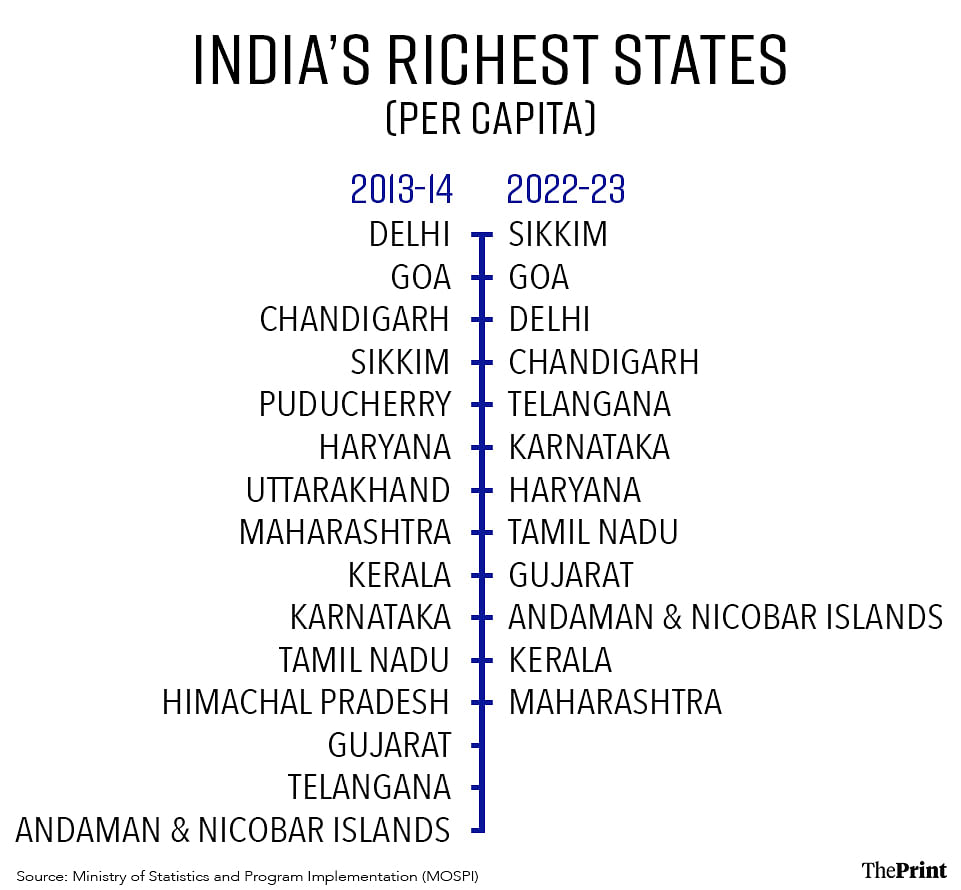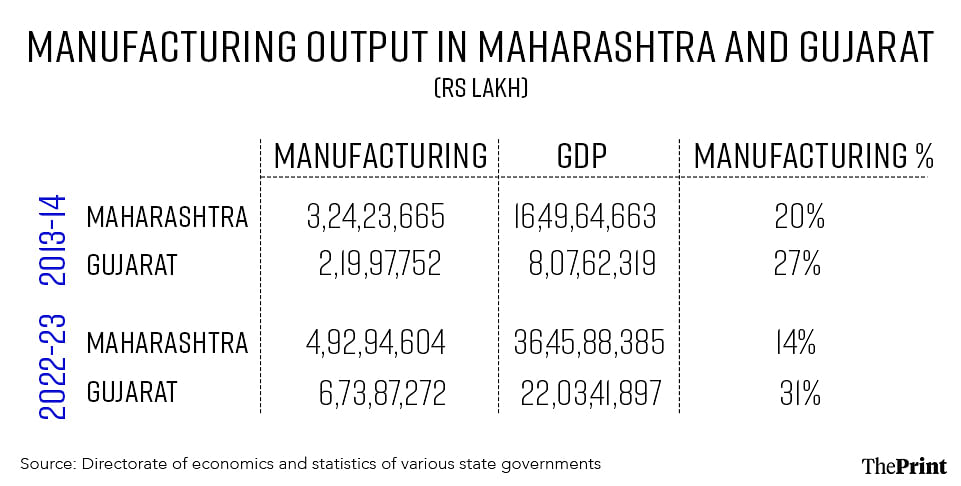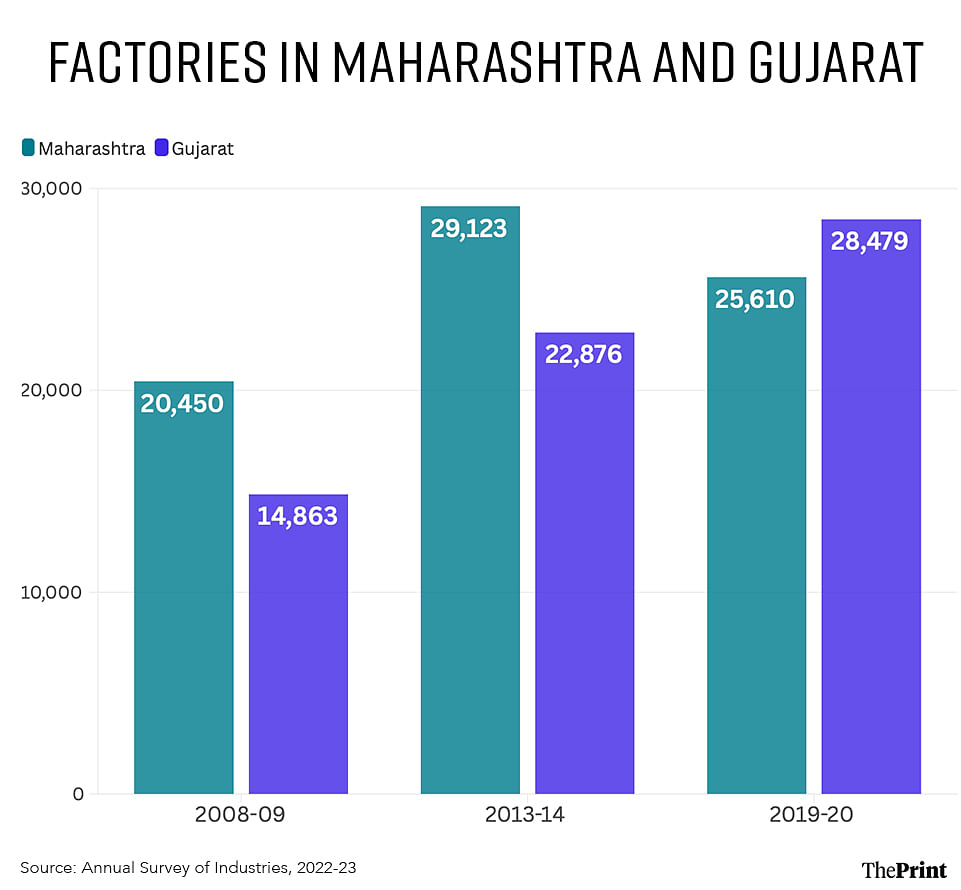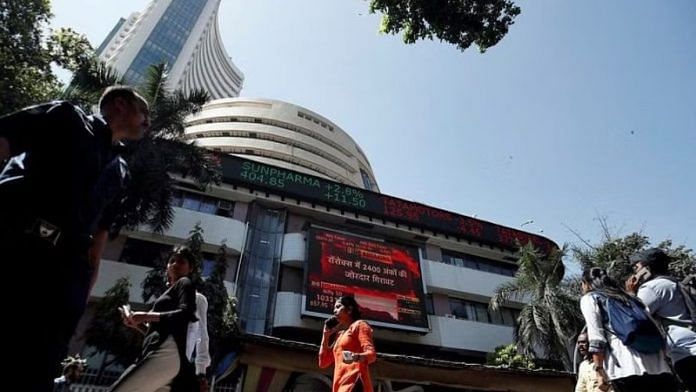Maharashtra and Gujarat have long shared a common history, whether as part of the Mughal Empire, the Maratha Confederacy, the Bombay Presidency and the Bombay State. Even after their separation in 1960, the two states were tightly linked commercially and together ensured that western India was the country’s premier manufacturing and trade centre.
However, something changed after Narendra Modi became prime minister in 2014.
The economic prospects of the two western states have diverged dramatically. Maharashtrians are keenly aware of how Gujarat has prospered in the past decade, both relatively and absolutely, snatching key projects and overtaking its sibling in wealth and economic success. This has caused Maharashtra to slide in the national rankings of per capita income, industrialisation and manufacturing, areas in which it was a national leader only a decade ago.
Opposition parties allege that this is due to systematic discrimination against Maharashtra, with major projects like Vedanta-Foxconn, Tata-Airbus, and businesses within the Bharat Diamond Bourse being steered to Gujarat instead. These would have added lakhs of jobs for unemployed Maharashtrians and generated lakhs of crores of income. Instead, the Mahayuti government in general, and Devendra Fadnavis in particular, has danced to New Delhi’s tune, steering business to the PM’s favourite businessman Gautam Adani whenever given the opportunity. The BJP’s insatiable hunger for power – at the expense of allies like the Shiv Sena – has overturned more than two decades of political stability in the state.
So, what’s the truth?
Maharashtra’s economic downfall
On the face of it, Maharashtra has a lot going for it. Its per capita income of Rs 2,77,603 in 2023-24 was almost two-and-a-half times the national average. An overwhelming majority of India’s biggest business houses and financial institutions are headquartered in Mumbai. As a result, Maharashtra accounted for 31 per cent of all foreign direct investment into India, leaving Karnataka (21 per cent) and Gujarat (16 per cent) behind.
Yet the past decade – for most of which the state has been ruled by the Mahayuti – has not been kind to Maharashtra, especially in comparison to its sibling Gujarat. In 2013-14, according to data from the Ministry of Statistics and Program Implementation (MOSPI), Maharashtra was India’s eighth richest state in per capita terms, ahead of its neighbours Gujarat, Karnataka and Telangana. In 2022-23, it had dropped to India’s twelfth wealthiest state, and all three states had raced past Maharashtra.

What most people don’t realise is that Maharashtra has de-industrialised in the past decade. In 2013-14, Maharashtra’s manufacturing output of Rs 3.2 lakh crore was 47 per cent higher than that of Gujarat. Only nine years later, in 2022-23, the value of manufacturing in Gujarat at Rs 6.7 lakh crore was 37 per cent higher than in Maharashtra. As a result, the contribution of manufacturing to state GDP in Maharashtra fell from 20 per cent to 14 per cent in less than a decade, while in Gujarat it rose from 27 per cent to 31 per cent.

What’s also shocking is how the industrial sector in Maharashtra has declined in recent years. The number of factories in the state rose by 42 per cent in the five years prior to 2014, and then declined by 12 per cent in the next six years (for which we have Annual Survey of Industries data). In Gujarat, the number of factories increased 25 per cent over the same six-year period. In India overall, the number of factories increased by nine per cent.

Also read: Modi pushed more Indians into low-paying farm jobs. UPA govt industrialised economy
Political instability to blame?
The logical counterargument to the Opposition’s charge of discrimination is that Gujarat has simply been more pro-business, offering incentives and land to attract investment. In contrast, political instability in Maharashtra has prevented the state from proactively competing with its neighbours.
But what this leaves out is the fact that the Bharatiya Janata Party (BJP)’s relentless drive for expansion has destabilised Maharashtra politics. In 2019, the Shiv Sena parted ways with its longtime ally over the chief ministership, and what it perceived as a domineering attitude. And when the Maha Vikas Aghadi looked like it was settling in as a stable government, the BJP used its usual combination of threats (Enforcement Directorate, Central Bureau of Investigation, and the Income Tax Department) and inducements, hatched in the alleged presence of Gautam Adani, to snatch two-thirds of the Shiv Sena away from Uddhav Thackeray, possibly a first in the long history of Indian political defections.
Sadly, the Mahayuti government has failed to stand up for Maharashtra. Could it be a coincidence that the coalition that was crafted, as Ajit Pawar claimed, in the presence of Adani ended up handing the Dharavi redevelopment project to the Adani Group in a highly restrictive contest in which the original winner was unable to participate? The Mahayuti government made a number of concessions, such as a much smaller up-front payment compared with the original contract (with much of it paid in instalments over 17 years), removing indexation and doubling the transferable development rights (TDR) that would accrue to the project.
TDR is a transferable credit that gives builders extra construction rights, often in more premium areas, in return for work done in low-income areas. This could lead to a windfall profit of 434 per cent according to some calculations.
Clearly, remote control governments – which the BJP likes to term “Double Engine” – have not delivered for Maharashtra in the past decade. When the priority is to please your boss and his financiers, you will end up with policies that benefit your paymasters.
The data is absolutely clear: in the past decade Maharashtra, once India’s shining star when it comes to industry, has de-industrialised and fallen behind its neighbouring states. Gujarat in particular has prospered under Modi’s decade.
Amitabh Dubey is a Congress member. He tweets @dubeyamitabh. Views are personal.
(Edited by Zoya Bhatti)







Data doesn’t lie dear Congress neta ! Gujarat was in the upswing always since 2003 ! your own graph illustrates that. Guess who brought political instability for the sake of power ? Hint : The ones who stopped metro shed construction and land acquisition for bullet train project and the ones who threw a spanner in the coastal roads project in the name of environment ! Dear Neta, your conclusions are correct but of course you will point your finger to the other side